SLIP OF THE TEETH
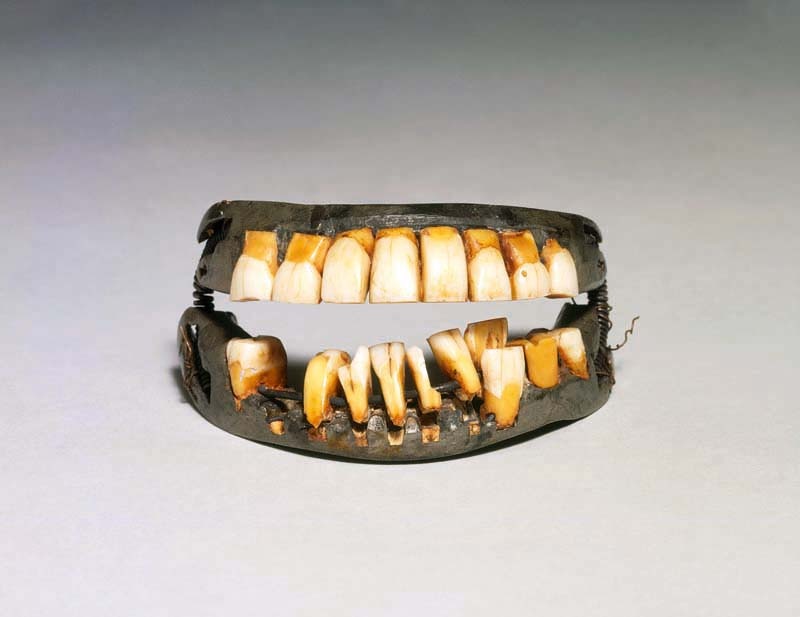
George Washingtons Gebiss / Dentures, 1790–99
To speak of free speech is to speak with, and of, the body. This is not a metaphor.
Consider the peculiar familiarity of your mouth. Pause to press on your gums, grasp the fleshy interiority of your cheek, run your tongue slowly over your teeth. Feel how strange the sensation of hard and soft, sharp and elastic; the gullies and ridges; the sudden flare of sensitivity as skin meets enamel, metal, nerve, bone. Most of our mouths contain amalgams of disparate matter fused at points of weakness and decay. Orifice, instrument, enunciative outlet – the mouth inhales, demands, ingests, and expels.
In 1789, when George Washington delivered his inaugural speech to the United States Congress, he did so with a festering mouth. [1] Washington was plagued by dental disease, and by 1789, he was in possession of only one of his own teeth. To address the nation, he wore dentures fashioned from a base of hippopotamus ivory carved to fit his gums. Several of the teeth were made from ivory and other animal bone; others were human teeth attached by means of gold screws. [2] Several likely belonged to the mouths of enslaved people. As a Mt. Vernon ledger entry of May 8, 1784, indicates, nine teeth were purchased on the plantation from unnamed “Negroes” (two, three, four? we do not know), who found themselves in the position of selling their teeth to Washington at a third of the going rate. [3]
(What could the free market mean for a slave?)
The myth that Washington had wooden teeth is a founding fiction, like the fable that he chopped down a cherry tree as a child. But the two legends operate in precise, material inversion. Faced with the evidence of the sundered tree, Washington supposedly confessed, “I cannot tell a lie.” The teeth that survive in Washington’s multiple dentures tell a different truth; one that begins with the fact that they are not wood at all. In the colonial ossuary of the mouth, the slave takes root in the master.
Washington’s dentures are a synecdoche for an unsentimental history of the United States of America. To foreground their materiality is to insist that political speech has always been a corporeal affair. Their entangled history gives lie to foundational narratives of citizenship and nation that presume the coherency and sovereignty of the individual subject who speaks, as well as to the freedom of this speech – in both its content and form. Here, we shift the coordinates of analysis from such lofty principles to matters of flesh, bone, breath: bodily and legalistic assemblages that exceed the bounds of personhood. This racialized economy of speech predates the nation and still structures aspects of it today.
For instance, Black lives matter. Black bodies matter. But when, and how, and to what ends? Black lives mattered at Mt. Vernon as their labor was exacted to produce wealth. Black bodies mattered when their matter vitalized Washington’s speech. In 1791, the First Amendment was adopted while lashes fell among swamps and stillbirths, rotting teeth and aching gums. The free speech it enshrined was hardly free in a universal sense, but closer to “that species of property” – as slaveowners referred to the enslaved – that only belonged to those in property of themselves.
When Washington’s dentist extracted teeth from his slaves and fashioned them into an apparatus facilitating speech, he also dispersed and multiplied the kinds of labor that an enslaved body was compelled to do. Most of that body would continue as before in the plantation, tongue pressing on empty sockets in healing gums. But the deracinated teeth now labored elsewhere in an inverted ventriloquism of the master’s speech, speaking the language of citizenship, free government, liberty, the public good.
Prosopopoeia is the rhetorical speech that gives voice to inanimate things. What, though, is the rhetorical speech animated by fragments of subjects whom slavery has rendered things? Is the commodity who speaks the inversion of personification? [4]
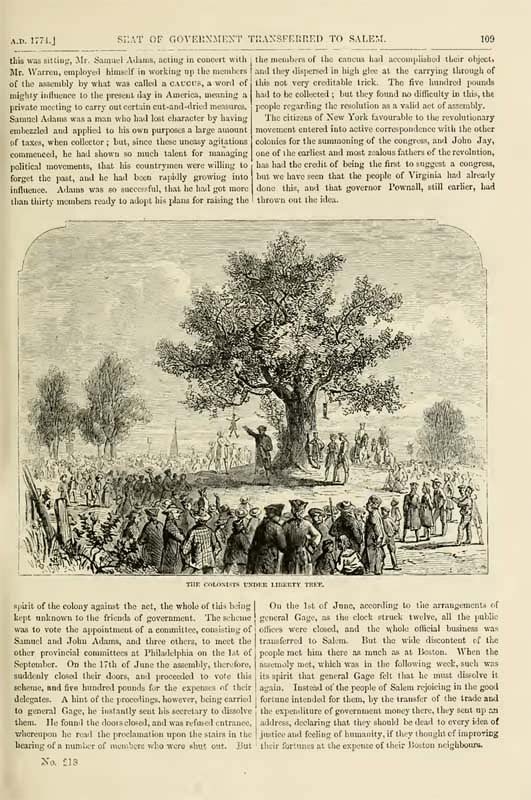
„The Colonists Under Liberty Tree“, John Cassell’s Illustrated History of England, 1865
Evident truths
In summer 2020, as protests multiplied and institutions navigated between the momentum of history and the inertia of tradition, debates about free speech ricocheted within conservative and liberal echo chambers. At Princeton University, hundreds of faculty members signed a letter demanding action to address racism in the academy, sending it to the university administration on July 4th. [5] The letter began, “Anti-Blackness is foundational to America,” observing, without equivocation, the causal relation between the nation’s formation and its history of coerced labor, death, and dispossession. Days later, professor of classics Joshua Katz published a response in which he contrasted his own family’s tradition of reading the Declaration of Independence aloud on July 4th with the “blunt sentence” that opens the faculty letter. [6] Katz seemed to opine that the letter’s demands for accountability for racist behavior and research presented a more ominous threat to free speech than racism itself.
But to assume a tradition of free speech in the United States demands abstracting the bodies from which speech issues. When Washington spoke as the first president of the United States, he did so literally through extractive means. White speech was enlivened by Black labor. The opening sentence of the July 4th Princeton faculty letter is true in a social and political sense, but also in a forensic sense – one that compels a shift in the symbolic coordinates of institution and nation, indeed, of the universitas that gives the university its name.
The oldest trees on Princeton’s campus are two sycamores planted by University President Samuel Finley in 1766 in homage to the Liberty Tree of Boston, where revolutionaries protested against the British Stamp Act of 1765. A few months after the planting, Finley’s slaves were sold at auction, meters away from where the new trees took root. [7] When we look at engravings of the Liberty Tree, we cannot help but also see the trees from which Black people were hung, their flesh tortured and mutilated. [8] Those who orchestrated and attended lynchings also acted in defense of liberty – the liberty for white citizens to ravage the Black body at will.
In which contexts are tongues allowed or disallowed to be unruly? Under what conditions is disruptive speech heard?

Louis Cameron, „Last Words: George Floyd #1“, 2020
FIGURES OF SPEECH
An enraged public removes statues from public space. The State removes people from social and biological life. Bots spew ceaseless “speech.” Corporations claim personhood. In the afterlives of slavery that are our present, subjugated life matters less than the endurance of frozen figures and animated algorithms.
In the months leading up to the 2020 election, Donald J. Trump explicitly linked the defense of free speech to what Paul B. Preciado has called “the sculptural biopolitics” of nation, that is, the governance of public space by means of “statuefied” bodies, and the contestation of that space by means of their removal. [9] In a speech at a September 2020 White House Conference on American History, Trump banned federal trainings using critical race theory and announced the creation of a 1776 Commission to “promote patriotic education” in the face of “the mob in the street” and the “cancel culture in the boardroom.” [10] He also pledged the addition of Caesar Rodney, a lesser-known signatory of the Declaration of Independence, to his proposed National Garden of American Heroes, a sculpture garden to be populated solely with “realistic” statuary. [11] As protestors toppled statues and called for abolition – an end to prisons that purposely evokes the end of slavery – Trump decreed that those guilty of demolishing federal statues would be sentenced to ten years in prison.
Eidolopoeia is the ventriloquism of the dead: to speak in the name of a phantom or idol. The executive order funding the National Garden of American Heroes declared that “statues are silent teachers in solid form of stone and metal” that belong to prior generations as well as those “yet unborn.” The phrasing is cued to pro-life conservatives, but it contains an extraordinary irony. [12] Rodney, like other signatories of the Declaration who were also slave owners, laid legal claim to the lives of the unborn children of enslaved women through the legal doctrine of partus sequitur ventrem – literally, the offspring follows the womb. The enslaved body was thus not only partitioned and multiplied in space; it was dispossessed in time, along with its progeny. [13] In Trump’s imagined National Garden, the “yet unborn” are summoned as proprietors rather than property: the rightful heirs to Rodney’s unliving, speechless form.
To figure a person or thing is to represent that entity through expressive means. A figure of speech is an expression that uses language figurally: Money talks. Keep a stiff upper lip. Bite your tongue. My lips are sealed. In its rhetorical marshaling in the fight against “the mob in the street,” the statue of Rodney figures the abstract notion of free speech. Paradoxically, any solid form that Rodney’s persona takes remains necessarily phantasmatic: Rodney never sat for a true portrait during his lifetime, owing to a facial cancer which his doctor excised, along with a significant chunk of his face. [14] Statues of Rodney may be realist in style, as Trump desired, but they can hardly be said to be realistic.
On January 6th, 2021, abstract and literal coordinates of figuration converged, willy-nilly, as right-wing insurgents stormed the US Capitol. Rioters wrapped in flags and allegorized as the Statue of Liberty appeared alongside a man making off with the lectern of the Speaker of the House. The marauders claimed to embody symbolic ideals by the fact of their protest but simultaneously suggested that the congressional symbol of speech must be literally captured and held hostage. In the immediate aftermath, the Chief of the Capitol Police indicated that the riot was a “First Amendment activity” gone horribly wrong. [15]
Seen through the lens of a bodily economy of speech, though, it is less surprising that this particular First Amendment event would transform into a seething mob. For, faced with the prospect that US representational democracy no longer represented white speech at the expense of other speech, it became imperative for protestors to assert their literal bodies within the symbolic space of the Capitol. The proliferation of images of rioters staging selfies with statues, glitchy video capturing screaming hordes, and testaments to insurrection proudly posted to social media proclaims the white body itself as justification. If there was any doubt as to the racialized economy of this body, however, we need look no further than the so-called QAnon Shaman, whose persona as “digital soldier” includes the appropriation of Native American ceremonial garb.
The confusion of bodies, symbols, language, and action on January 6th is symptomatic, for freedom of speech has always been a figure of speech in the double sense of the term. Technically, it has belonged to a specific and limited group of bodies. Theoretically, it is a notoriously mutable proposition comprising variable and often conflicting stances. In ancient Greece, rhetoricians distinguished between isegoria (equal speech in public) and parrhesia (frank, even offensive speech), a distinction often confused in current debates. [16] Moreover, parrhesia inheres in a social relation: it is directed to the powers that be, with risk to the speakers themselves. [17] Parrhesia comes from below. To invoke free speech from the position of white supremacy – as Trump and his allies have done – is the utter perversion of “speaking truth to power.”
The legal defense of free speech is likewise riddled with historical lacunae. In 1937, for example, the Supreme Court renewed its defense of the First Amendment, “the matrix, the indispensable condition, of nearly every other form of freedom.” [18] But the Constitution and the First Amendment were coeval with the whip, the hold, and the iron muzzle. The appeal to “every other form of freedom” thus contains within it the historical condition of unfreedom. In other words, in the United States, free speech – that indispensable condition – began by bracketing and denying Black freedom.
A woman protesting COVID-19 mask mandates in May of last year neatly diagrams the persistence of this relation in our contemporary, pandemic times. In the sign she holds, an image of Anastacia, an enslaved Afro-Brazilian woman muzzled by a metal contraption bound to her head and neck, figures the inverse of the “free human being” to which the protestor lays claim.
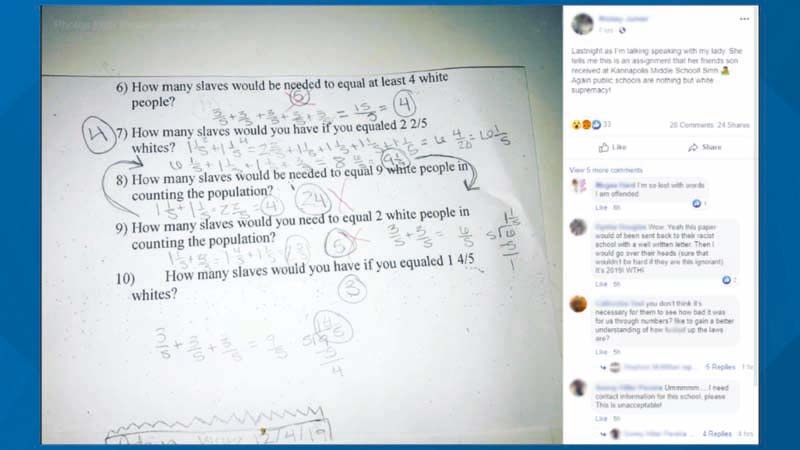
Sozialkundeaufgabe für die Mittelstufe / Middle school social studies assignment, Kannapolis, North Carolina, 2019
MULTIPLICATION AND DIVISION
What does it mean to possess one’s body and its emanations? In his work on the shifting nature of intellectual property in the 19th-century United States, Stephen Best notes that the drift toward “the commodification of personhood,” such that the very notion of the person was “fragmented into its various attributes, capacities, and ‘properties,’” found its internal analogy in the legal code’s reckoning with the ontological problem of the slave. [19] Did owners own the totality of the person or simply their labor? With the Fugitive Slave Act of 1850, the fugitive became two bodies in one – “pilfered property and indebted person,” as Best puts it – inaugurating a drive toward the alienation and abstraction of persons from intangible features such as their own image, voice, or thought. [20]
Soon, new instruments of mechanical reproduction, such as the gramophone, rendered the voice acousmatic, severed from its source. In the wake of these new media, property rights for such intangible emanations became a form of fugitive capture enacted through contract law. But such a conception springs from the prior notion of fugitive slaves as active participants in contracts of labor services, services of which they were in default when they attempted to escape. [21]
Of course, unlike the recorded voice, enslaved peoples’ labor could not be separated from their bodies, or at least not usually. For the purposes of capture, form and content, vessel and substance, were one. This is why the implanted teeth of Washington’s dentures form a paradigmatic exception. In severing but simultaneously multiplying the labor of the enslaved body, the dentures perform the sheer violence of slavery’s ontological equivocation. By grafting shards of that enslaved body (bodies) into the mouth of the master, the dentures anticipate – in forensic form – the mechanism by which the law manufactures a fantasy of consent. And in creating a material assemblage dependent on the extraction, commodification, and fragmentation of life, the dentures belie the notion that speech is self-identified, free, and sovereign for the slave but also for the master.
The partitioning of the enslaved body haunts the logic of political representation and speech in the United States. The three-fifths compromise allowed slaveholders to count enough of an enslaved body to gain access to state coffers and electors, but not enough to force recognition of citizenship or personhood. The deformation of representational democracy that began in that compromise continues in the Electoral College today. [22] And the Fourteenth Amendment, ratified in 1868, made formerly enslaved people citizens, granting them equal protection and due process under the law. Since 1886, however, the same amendment has been used to secure the personhood and later the “speech” of corporations. Slavery, as Best writes, left behind “its unique scandal of value.” [23]
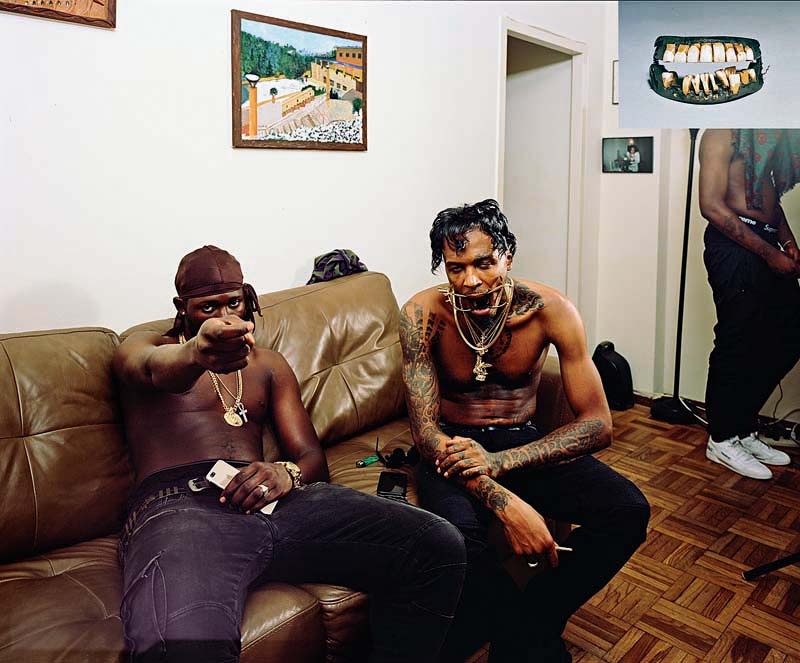
Deana Lawson, „Nation“, 2018
FORENSICS OF NATION
George Floyd: I’m through, I’m through. I’m claustrophobic. My stomach hurts. My neck hurts. Everything hurts. I need some water or something, please. Please? I can’t breathe, officer.Derek Chauvin: Then stop talking, stop yelling.George Floyd: You’re going to kill me, man.Derek Chauvin: Then stop talking, stop yelling, it takes a heck of a lot of oxygen to talk.George Floyd: Come on, man. Oh, oh. I cannot breathe. I cannot breathe. Ah! They’ll kill me. They’ll kill me. I can’t breathe. I can’t breathe. Oh! [24]
In psychoanalysis, projection is the process by which the unconscious attribute of one person is imagined to be the purview of another. It is therefore not surprising that anti-Black rhetoric – in the guise of the defense of free speech – calls out against “cancel culture.” But in the United States and the Atlantic world more broadly, true cancellation – if by cancel we mean limiting someone’s ability to speak, to participate in the public sphere, or indeed to speak at all – describes the longue durée for people of color. It was illegal for enslaved people to read and write in many slave societies. The communicative language of drumming was banned throughout the slaveholding Atlantic world.
Lynching is the spectacle of snuffing out breath, the vitality of life and the medium of utterance, exclamation, speech. As Vanessa Stovall observed in relation to certain sanctimonious claims, it is the ur-cancellation. [25] In the continuing epidemic of death-by-asphyxiation, words are silenced along the way to choking off breath. The refrain of protesting voices, “I can’t breathe,” is the amplification of “Black disbelief, a desire for otherwise air,” as Ashon T. Crawley puts it, in the face of this litany of racialized violence. [26] As a refrain, it demands that a truth experienced and expressed by the Black body be recognized as such; that this body be attended to, heard.
But “I can’t breathe” also signals a precise calculus of political possibility iteratively performed by the police response: “If you’re talking, you’re breathing. I don’t want to hear it,” declared Deputy Mechelle Denton to Willie Ray Banks, who died shortly thereafter. [27] This is the paradox of Black citizenship in a state armored by white supremacy: you are permitted to breathe if you stop talking, but you cannot do both at once.
When we watched George Floyd’s murder last summer, we witnessed the call and response of this perverse equation. Floyd’s murder was citational: it mobilized an instrument of terrorism inextricable from the iconography of moral appeal and protest that punctuates the history of abolition and civil rights in the United States. Police choking speech from Black bodies; bended knees imploring for freedom; kneeling as silent denouncement, mourning, rageful dissent. The mongrel mouth, the congruency of these knees: these embody the terrifying experiment that is the United States.
Dave Chappelle: This is my impression of the “Founding Fathers of America” when the Constitution was being written. You ready? Here it goes: “Hurry up and finish that Constitution, n****, I’m trying to get some sleep!”* [28]
The current moment demands a forensics of nation, not an idealization. But this is not to suggest that that the evidence speaks for itself. As Eyal Weizman and Thomas Keenan have argued, forensics refers to the forum where orators practiced, prosopopoeia, thus giving voice to inanimate things. [29] Forensics is rhetorical and aesthetic as much as scientific, and it binds together object and speaker through the act of interpretation. Likewise, the forum in which such interpretation unfolds is not given “but is produced through a series of entangled performances,” as Keenan and Weizman write. “Forums are gathered precisely around disputed things.” [30] A forensics of nation therefore entails assembling around that which idealization refuses: the thingification of persons; the partitioning of persons for the purposes of speech.
Deana Lawson’s 2018 Nation is one such gathering: an assortment of bodies, props, performances, and spectral presences that prick the viewer’s flesh. In the work, Washington’s dentures grimace from an inset in the upper right corner, hovering over the ostensible diegesis of the scene. Here, in a room, we see three Black male protagonists: two face the viewer head-on from the couch; a third, who wears a scarf decorated with grinning skulls, is functionally decapitated by the image of the teeth. One of the seated men wears a ghastly orthodontic device, the image of which came to Lawson in a dream. For the shoot, Lawson spray-painted the device gold and positioned it alongside an assortment of gold jewelry she invited the participants – hip-hop artists in their own right – to wear. The resulting photograph is a parafiction born of this encounter, riddled with what fellow artist and filmmaker Arthur Jafa calls the “disjunctions” of representational surface and sociality alike. [31] The image of the teeth – tucked into the golden frame like a grisly family photo – locks together this chain of incommensurabilities. The dentures lie in a physically distinct plane, yet the viewer cannot help but join them to the mouth of the man with the dental apparatus, unleashing a chain of temporally impossible causalities. Are the brittle teeth a prologue or a haunting? Are we the target of the gun, conjured by the other man’s outstretched hand? Or is it we who perform the violence of the shot from the other side of the frame?
Jafa has described Lawson’s photographs as X-rays that pierce the surface of images and subjects. They look past “surface scars,” he observes, to “the things that typically fall outside of the seen,” even though the visible, paradoxically, is what photography captures. [32] Nation: three Black men surveilled by a macabre relic. How does this staging of the body politic square with the horror of what politics does to Black bodies? What bile and beauty does the image spew? What does it compel us to see?
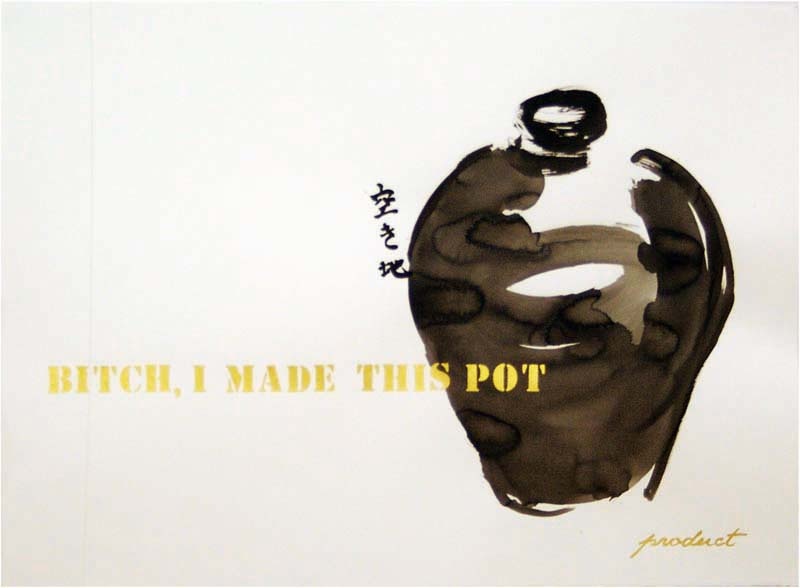
Theaster Gates, „Bitch I Made This Pot“, 2013
THE MATTER OF FUGITIVE SPEECH
Lawson’s Nation is a surplus of forensics: an X-ray that accumulates entanglement rather than strips it away. Its attention to gaping mouths and dental devices recalls and remixes prosopopoeia as the embodied short-circuit of master and slave.
But how to limn speech that speaks from the other side of legal and bodily partition? A 19th-century African American potter named Dave from Edgefield, South Carolina, offers one indication. Flouting an 1834 state law that outlawed literacy for slaves and free Blacks, Dave inscribed multiple pots with verses of his own creation. Scholars believe Dave was born around 1801, the same year in which Thomas Jefferson gave his inaugural address as the third US president. [33] In that speech, Jefferson outlined “the essential principles of our Government, [. . .] stating the general principle, but not all its limitations.” [34] The opening principles deserve special mention: “Equal and exact justice to all men, of whatever state or persuasion, religious or political; peace, commerce, and honest friendship with all nations, entangling alliances with none.” [35] In 1857, a decade after it appears that his wife and six children were sold away, Dave wrote:
I wonder where is all my relationsFriendship to all – and, every nation [36]
The first line invokes the wrenching apart of Dave’s own family, embedding within his devastating query the plight of all enslaved families and millions of uprooted Africans shipped across the Atlantic. The formulaic goodwill of the next line attempts to seal over this gash. Yet in speaking as precisely that limitation to Jefferson’s body politic, Dave transforms the president’s isolationist vision of national sovereignty into an articulation of diasporic relations as expansive, entangled, and interior as the alliances Jefferson disavowed.
But who, or what, constitutes the speech of this political rejoinder?
On July 31, 1840, Dave inscribed a verse on the wet surface of a clay vessel, together with the date:
Dave belongs to Mr. MilesWher the oven bakes and the pot biles [37]
Here, speech is coincident with its support and, like any writing, separates the words from their author. But Dave’s verse marks a further displacement, for he, the author, “belongs to Mr. Miles,” much like the pot that he makes. The life-size dimensions of several of his vessels, often signed “Dave” and “L. M.” (for Lewis Miles), conjoin corporeality and objectification at the site of enunciation. As literary scholar Michael A. Chaney writes, “The thing ‘Dave’ hereby replicates more things named ‘Dave’ through a process of reproductive nomination,” one that both “call[s] forth and call[s] away the subject [his] signature endeavors to name.” [38]
From this perverse oscillation between subject and thing, Dave renders matter agential: it is the oven that bakes and the pot that boils. Or does it bile? The rhyme is compelled by the leading line of Mr. Miles. Nearby Gullah Geechee pronunciations of “boil” likewise suggest its intentionality. [39] Yet the rhyme also spectacularly exceeds its phonic necessity. For bile is the bitter substance secreted by the liver, its palette ranging from brown to yellow to green, not unlike the earthen alkaline glazes Dave applied to his wares. Bile is a medieval humor – black for melancholy, yellow for anger and ill temper – a temperamental effect of choler and phlegm. A record, a warning, a chain of inflection that runs from bodily fluid to disposition, subject to object, slave to master and back again.
The bile boils as the oven bakes.
In certain etymologies, bile means boil, but also lip, brim, edge, rim: the projecting boundary that marks the opening of a vessel or body; the border beneath which Dave wrote verses on his pots. Lips with no teeth, Dave’s pots speak, unfreely, in a material language of radical refusal. His speech, which is his and not his, recalibrates the rhythm of subjection, delivering truth as a punch to the gut.
Rub your tongue against your gums; are they boiling?
Notes
| [1] | On Washington’s relation to these prosthetics, see Jennifer Van Horn, “George Washington’s Dentures: Disability, Deception, and the Republican Body,” Early American Studies: An Interdisciplinary Journal 14, no. 1 (Winter 2016): 2–47. Washington had multiple dentures made for him and received dental work from several dentists, including John Greenwood, who fashioned the pair for his inauguration, and Jean-Pierre Le Mayeur, to whom the “Negro” teeth noted in the ledger book appear to have been delivered. See Mary V. Thompson, The Only Unavoidable Subject of Regret: George Washington, Slavery, and the Enslaved Community at Mount Vernon (Charlottesville: University of Virginia Press, 2019), 229. See also Beatriz E. Balanta and Mary Walling Blackburn, “Sticky Notes, Part B (4–17),” e-flux journal 94 (October 2018). |
| [2] | Malvin E. Ring, “John Greenwood, Dentist to the President Washington,” California Dental Association Journal 38, no. 12 (December 2010): 847–851. |
| [3] | George Washington Ledger B, 1772–1793, May 8, 1784, p. 179, Library of Congress, cited in Kathryn Gehred, “Did George Washington’s False Teeth Come From His Slaves?: A Look at the Evidence, the Responses to That Evidence, and the Limitations of History,” The Washington Papers (blog), University of Virginia, October 19, 2016, https://washingtonpapers.org/george-washingtons-false-teeth-come-slaves-look-evidence-responses-evidence-limitations-history/#_edn1. |
| [4] | On slavery and the speaking commodity, see Fred Moten, In the Break: The Aesthetics of the Black Radical Tradition (Minneapolis: University of Minnesota Press, 2003), 6. See also Lynn Festa, Sentimental Figures of Empire in Eighteenth-Century Britain and France (Baltimore: Johns Hopkins University Press, 2006). |
| [5] | Princeton University Faculty to University Administration, open letter, July 4, 2020, https://docs.google.com/forms/d/e/1FAIpQLSfPmfeDKBi25_7rUTKkhZ3cyMICQicp05ReVaeBpEdYUCkyIA/viewform. |
| [6] | Joshua Katz, “A Declaration of Independence by a Princeton Professor,” Quillette, July 8, 2020, https://quillette.com/2020/07/08/a-declaration-of-independence-by-a-princeton-professor/. |
| [7] | “Two Women, a Man and Three Children,” Pennsylvania Journal, July 31, 1766. Accessed at The Princeton & Slavery Project, https://slavery.princeton.edu/sources/two-women-a-man-and-three-children. |
| [8] | On the distinction between body and flesh, see Hortense J. Spillers, “Mama’s Baby, Papa’s Maybe: An American Grammar Book,” Diacritics 17, no. 2 (Summer 1987): 64–81. |
| [9] | Paul B. Preciado, “When Statues Fall,” Artforum 59, no. 3 (December 2020). |
| [10] | White House, “Remarks by President Trump at the White House Conference on American History,” National Archives Museum, Washington, DC, September 17, 2020, https://trumpwhitehouse.archives.gov/briefings-statements/remarks-president-trump-white-house-conference-american-history/. |
| [11] | White House, “Executive Order on Building and Rebuilding Monuments to American Heroes,” White House, Washington, DC, July 3, 2020, https://trumpwhitehouse.archives.gov/presidential-actions/executive-order-building-rebuilding-monuments-american-heroes/. |
| [12] | Exec. Order No. 13,934 (July 3, 2020), 85 FR 41165, https://www.federalregister.gov/d/2020-14872. |
| [13] | On partus sequiter ventrem, see Jennifer L. Morgan, “Partus sequitur ventrem: Law, Race, and Reproduction in Colonial Slavery,” Small Axe 22, no. 1 (March 2018): 1–17. As Morgan notes, the North American allusion to the Latin term for the reproductive slave law echoed its use in Iberian slave law, notably in Alfonso X’s Siete Partidas. |
| [14] | William Frank, “Caesar Rodney Patriot Delaware’s Hero for All Times” (Wilmington: Delaware American Revolution Bicentennial Commission, 1975), https://archives.delaware.gov/wp-content/uploads/sites/156/2017/05/CeasarRodneyPatriot.pdf. |
| [15] | US Capitol Police, “Statement of Steven Sund, Chief of Police, Regarding the Events of January 6, 2021,” press release, January 7, 2021, https://www.uscp.gov/media-center/press-releases/statement-steven-sund-chief-police. |
| [16] | Teresa M. Bejan, “The Two Clashing Meanings of ‘Free Speech,’” Atlantic Monthly, December 2, 2017. Erwin Chemerinsky and Howard Gillman provide a useful history of free speech concepts and usage, locating the nascent US precedent in late 17th-century and early 18th-century English law and thought in Free Speech on Campus (New Haven: Yale University Press, 2017), 29. |
| [17] | Michel Foucault, “Discourse and Truth” and “Parresia,” eds. Henri-Paul Fruchaud and Daniele Lorenzini (Chicago: University of Chicago Press, 2019). |
| [18] | Quoted in Chemerinsky and Gillman, Free Speech on Campus, 82. |
| [19] | Stephen M. Best, The Fugitive’s Properties: Law and the Poetics of Possession (Chicago: University of Chicago Press, 2004), 37–38. |
| [20] | Ibid., 9. |
| [21] | Ibid., particularly Chapter 1, “Fugitive Sound: Fungible Personhood, Evanescent Property,” 29–98. |
| [22] | See, among other recent debates on the embedding of the three-fifths clause into the logic of the Electoral College, Akhil Reed Amar, “Actually, the Electoral College Was a Pro-Slavery Ploy,” New York Times, April 6, 2019; Alan Singer, “Slavery and the Electoral College: One Last Response to Sean Wilentz,” History News Network, Apr 21, 2019, https://historynewsnetwork.org/article/171783. |
| [23] | Best, The Fugitive’s Properties, 13. |
| [24] | State of Minnesota v. Derek Michael Chauvin. Transcript of “Axon_Body_3_Video_2020-5-25_2008” in Exhibit of Defense, 2: 27-CR-20-12951, p. 16, https://int.nyt.com/data/documenthelper/7070-exhibit-final07072020/4b81216735f2203a08cb/optimized/full.pdf#page=1. |
| [25] | Vanessa Stovall, “The Haunting of Joshua T. Katz: On Tantric Mammification and Liquid Symptoms,” Medium, July 11, 2020. |
| [26] | Ashon T. Crawley, Blackpentecostal Breath: The Aesthetics of Possibility (New York: Fordham University Press, 2016), 2. |
| [27] | Mike Baker, Jennifer Valentino-DeVries, Manny Fernandez, and Michael LaForgia, “Three Words. 70 Cases. The Tragic History of ‘I Can’t Breathe,’” New York Times, June 29, 2020. |
| [28] | Dave Chappelle, Sticks and Stones, directed by Stan Lathan (Netflix, aired August 26, 2019), 504. |
| [29] | Eyal Weizman, “Forensic Architecture: Only the Criminal Can Solve the Crime,” Radical Philosophy 164 (November/December 2010): 9–24; Thomas Keenan and Eyal Weizman, Mengele’s Skull: The Advent of Forensic Aesthetics (Berlin: Sternberg Press, 2012). |
| [30] | Keenan and Weizman, Mengele’s Skull, 29. |
| [31] | Deana Lawson and Arthur Jafa, “A Match Made in Heaven: Deana Lawson and Arthur Jafa on Destiny, Intuition, and Influence,” Garage Magazine 15 (September 4, 2018). See also Deana Lawson, “Deana Lawson’s Nation,” interview by Roxana Marcoci, MoMA Magazine, July 19, 2019; Helen Molesworth, “Deana Lawson at Sikkema Jenkins,” Artforum 57, no. 4 (December 2018): 150–153; and Anna Arabindan-Kesson, “Seeing Empire,” Panorama: Journal of the Association of Historians of American Art 6, no. 1 (Spring 2020). |
| [32] | Lawson and Jafa, “A Match Made in Heaven.” |
| [33] | Jill Beute Koverman, ed., “I Made This Jar”: The Life and Works of the Enslaved African-American Potter, Dave, exh. cat. (Columbia: McKissick Museum, University of South Carolina, 1998); Leonard Todd, Carolina Clay: The Life and Legend of the Slave Potter Dave (New York: Norton, 2008). |
| [34] | On Dave’s relation to Jefferson’s address, see Jon Woodson, “Beneath Notice: A Social Philology of the Poetry of Dave the Potter,” in Where Is All My Relation? The Poetics of Dave the Potter, ed. Michael Chaney (Oxford: Oxford University Press, 2018), 177–192. |
| [35] | Thomas Jefferson, “First Inaugural Address,” March 4, 1801, accessed at https://avalon.law.yale.edu/19th_century/jefinau1.asp. |
| [36] | See catalogue item no. 21 in Koverman, “I Made This Jar,” 97. |
| [37] | See catalogue item no. 10 in Koverman, 96. |
| [38] | Michael A. Chaney, “The Concatenate Poetics of Slavery,” in Where Is All My Relation?, 121, 112. |
| [39] | Lorenzo Dow Turner, Africanisms in the Gullah Dialect (Columbia: University of South Carolina Press, 2002), 21. |
